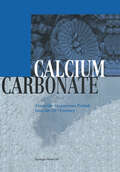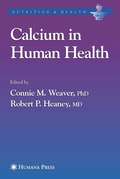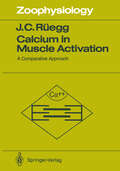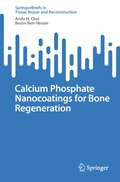- Table View
- List View
Calcium Binding Proteins (Wiley Series in Protein and Peptide Science #5)
by Eugene Permyakov Robert H. KretsingerCalcium Binding Proteins explains the unique and highly diverse functions of calcium in biology, which are realized by calcium binding proteins. The structures and physical characteristics of these calcium binding proteins are described, as well as their functions and general patterns of their evolution. Techniques that underlie the description of proteins are discussed, including NMR, circular dichroism, optical rotatory dispersion spectroscopy, calorimetry,and crystallography. The book discusses the patterns of bochmical phenomena such as calcium homeostasis, mineralization, and cell signaling that involve specific proteins. It summarizes ongoing research and presents general hypotheses that help to focus future research, and also provides a conceptual framework and a description of the underlying techniques that permits someone entering the field to become conversant.
Calcium Binding Proteins (Wiley Series in Protein and Peptide Science #15)
by Eugene Permyakov Robert H. KretsingerCalcium Binding Proteins explains the unique and highly diverse functions of calcium in biology, which are realized by calcium binding proteins. The structures and physical characteristics of these calcium binding proteins are described, as well as their functions and general patterns of their evolution. Techniques that underlie the description of proteins are discussed, including NMR, circular dichroism, optical rotatory dispersion spectroscopy, calorimetry,and crystallography. The book discusses the patterns of bochmical phenomena such as calcium homeostasis, mineralization, and cell signaling that involve specific proteins. It summarizes ongoing research and presents general hypotheses that help to focus future research, and also provides a conceptual framework and a description of the underlying techniques that permits someone entering the field to become conversant.
Calcium-Binding Proteins and RAGE: From Structural Basics to Clinical Applications (Methods in Molecular Biology #963)
by Claus W. HeizmannA major direction in medical research leading to clinical applications targets the regulation of intracellular calcium and the various human diseases associated with an altered homeostasis of this global second messenger. These diseases include, for example: cardiomyopathy, inflammation, brain disorders, diabetes and cancer. In Calcium-Binding Proteins and RAGE: from Structural Basics to Clinical Applications,expert researchers in the field detail many of the methods which are now commonly used to study calcium binding proteins. These methods and techniques, such as calcium-measurements, screening methods, clinical chemistry, and therapy, are generally applicable to many other areas of basic and medical research as well as to diagnostics. Written in the highly successful Methods in Molecular Biology™ series format, chapters include introductions to their respective topics, lists of the necessary materials and reagents, step-by-step, readily reproducible laboratory protocols, and key tips on troubleshooting and avoiding known pitfalls. Authoritative and practical,Calcium-Binding Proteins and RAGE: from Structural Basics to Clinical Applications underlines the diagnostic and clinical importance of this family of proteins in human diseases and as drug targets.
Calcium Binding Proteins in Normal and Transformed Cells (Advances in Experimental Medicine and Biology #269)
by R. Pochet D. Eric M. Lawson Claus W. HeizmannProceedings of the First European Symposium held in Brussels, Belgium, April 20--22, 1989
Calcium-Binding Proteins in the Human Developing Brain (Advances in Anatomy, Embryology and Cell Biology #165)
by N. Ulfig"This book is primarily written for neuroscientists who will always be interested in the role of calcium in the internal neuronal environment. The objectives are well met. The authors are credible authorities in the field and are the most appropriate to discuss calcium in neuronal development...Through multiple excellent quality pictures, this book shows evidence of the potential roles of calcium in the modulation of development as well as on the determination of programmed cell death. " Review from Doody's Notes
Calcium-Binding Proteins of the EF-Hand Superfamily: From Basics to Medical Applications (Methods in Molecular Biology #1929)
by Claus W. HeizmannThis detailed volume explores protocols for studying the many facets of Ca2+-imaging, Ca2+-signaling, and Ca2+-binding along with background information on the principles and application of these techniques. The content of the book delves into 48 chapters including subjects such as data analysis and modern technologies to study calcium-binding and signaling in cells, the superfamily of calcium-binding proteins characterized by the EF-hand structural motif, as well as their use as diagnostic and prognostic biomarkers in Laboratory Medicine and novel therapeutic drug targets. Written for the highly successful Methods in Molecular Biology series, chapters include introductions to their respective topics, lists of the necessary materials and reagents, step-by-step, readily reproducible laboratory protocols, and tips on troubleshooting and avoiding known pitfalls. Authoritative and comprehensive, Calcium-Binding Proteins of the EF-Hand Superfamily: From Basics to Medical Applications presents state-of-the-art, lab-based methods and easy-to-follow protocols for daily use, making it interesting for basic and medical researchers, cell- and molecular biologists, clinicians, clinical chemists, and the diagnostic industry.
Calcium Carbonate: From the Cretaceous Period into the 21st Century
by J. Rohleder E. KrokerI. G OLOGY OF CALCIUM CARBO ATE 1 by Jacques Geyssant 1. Features and characteristics of calcium carbonate 2 1. 1 Calcium carbonate - a special compound 2 1. 2 The crystal forms of calcium carbonate - mineralogy 9 2. The limestones - development and classification 15 2. 1 Sedimentation 16 2. 2 Diagenesis - from sediment to rock 23 2. 3 Classification of the limestones 24 2. 4 Metamorphism - from limestone to marble 26 2. 5 Carbonatites - extraordinary limestones 29 3. Limestone deposits 31 3. 1 Recognition of limestones 31 3. 2 Distribution on the Earth's surface 33 3. 3 Limestone deposits in the geological ages 36 3. 4 CaC0 cycle 42 3 3. 5 Industrially exploitable CaC0 deposits 3 44 53 II. TH C LT RAt HI TORY F LIME TONE by Johannes Rohleder 1. The history of chalk 55 2. Marble and limestone 69 2. 1 Quarrying stones 70 2. 2 Transport, organisation and trade 80 2. 3 The uses 97 137 III. CALCI M CARBOl\ATE - A MODER RESOURCE 1. The beginnings: Calcium carbonate in glazing putty and rubber 138 by Johannes Rohleder 1. 1 A chalk industry is born 139 1. 2 Rubber and glazing putty 142 1. 3 From chalk to calcium carbonate 156 2. Calcium carbonate - pigment and filler 160 by Eberhard Huwald 2. 1 Properties and effects of a filler 164 2. 2 Chalk, limestone, marble, pec - common features and differences 165 2. 2.
The Calcium Channel: Stresa/Italy, May 11–14, 1988 (Bayer AG Centenary Symposium)
by Martin Morad Winifred G. Nayler Stanislav Kazda Matthias SchrammThis is the first book to summarize experimental results from the new, rapidly expanding field of research into the calcium channel in cell membrane. Calcium is an ubiquitous messenger of various cellular functions. Its fundamental role in the regulation of cardiac contractions has long been recognized. Drugs counteracting some actions of calcium ions, namely calcium antagonists, have since become essential to research. In the last decade it has been established that calcium ions reach their target intracellular system by passing through specialized calcium channels in the membrane. Recently improved experimental techniques combined with the discovery of highly specific Ca channel ligands have dramatically enlarged our knowledge of the molecular structure and function of such channels. The contributions by leading world specialists shed new light on both basic science and possible clinical implications for cardiovascular pharmacology, endocrinology and neuropharmacology.
Calcium Channel Pharmacology
by Stefan I. McDonoughVoltage-gated calcium channels are critical regulators of cytoplasmic levels of calcium, the universal signaling ion. As such, calcium channels trigger a wide range of cellular functions, from muscle contraction to neurotransmitter secretion, and are important players in human disease. Prominent in the nervous, cardiovascular, and endocrine systems, members of the calcium channel family are targets for existing antihypertensive and anticonvulsant drugs. In addition, they are emerging targets for drugs to treat an extraordinarily diverse group of disorders, including pain, cerebral ischemia, cardiac arrhythmia, and migraine. This book reviews the compounds that target individual calcium channel subtypes and the cellular and behavioral functions governed by each different channel. It contains information for basic scientists using calcium channel antagonists as experimental tools, for behavioralists studying animal models of human disease, and for pharmaceutical scientists interested in creating the next generation of calcium channel-targeted drugs. Several factors make an entire book on calcium channel pharmacology timely.
Calcium Entry Channels in Non-Excitable Cells (Methods in Signal Transduction Series)
by Juliusz Ashot Kozak James W. PutneyCalcium Entry Channels in Non-Excitable Cells focuses on methods of investigating the structure and function of non-voltage gated calcium channels. Each chapter presents important discoveries in calcium entry pathways, specifically dealing with the molecular identification of store-operated calcium channels which were reviewed by earlier volumes in the Methods in Signal Transduction series. Crystallographic and pharmacological approaches to the study of calcium channels of epithelial cells are also discussed. Calcium ion is a messenger in most cell types. Whereas voltage gated calcium channels have been studied extensively, the non-voltage gated calcium entry channel genes have only been identified relatively recently. The book will fill this important niche.
Calcium Entry Channels in Non-Excitable Cells (Methods in Signal Transduction Series)
by Juliusz Ashot Kozak James W. PutneyCalcium Entry Channels in Non-Excitable Cells focuses on methods of investigating the structure and function of non-voltage gated calcium channels. Each chapter presents important discoveries in calcium entry pathways, specifically dealing with the molecular identification of store-operated calcium channels which were reviewed by earlier volumes in the Methods in Signal Transduction series. Crystallographic and pharmacological approaches to the study of calcium channels of epithelial cells are also discussed. Calcium ion is a messenger in most cell types. Whereas voltage gated calcium channels have been studied extensively, the non-voltage gated calcium entry channel genes have only been identified relatively recently. The book will fill this important niche.
Calcium Entry Pathways in Non-excitable Cells (Advances in Experimental Medicine and Biology #898)
by Juan A. RosadoCalcium entry pathways in non-excitable cells presents a concise synthesis of thoughtfully selected topics covering from the different calcium entry mechanisms in non-excitable cells to the cellular microdomains and organelles regulating the calcium entry process. Particular attention is given to the fascinating group of ion channels involved in different calcium entry pathways as well as the emerging role of these channels in human disease. Calcium entry is an essential mechanism for cellular function in non-excitable cells. In general, two main calcium entry pathways exist in non-excitable cells: one pathway, named store-operated calcium entry (SOCE) requires store depletion and the second pathway is regulated by receptor occupation, but independently on calcium store depletion. The search for the molecular components of calcium entry has identified the stromal interaction molecule 1 (STIM1), as the calcium sensor of the intracellular calcium stores, and Orai as well as TRP channels as the calcium-permeable channels located in the plasma membrane. The location, interactions and function of these channels are finely regulated by a number of scaffolding proteins, membrane microdomains and cellular organelles that fine tune the amount of calcium entering the cell. Cutting-edge and user-friendly, this volume presents relevant background information, critical analysis of the current observations and directions for future research. The book is intended for basic scientists specializing in cellular biology or ion transport, as well as for biomedical researchers.
Calcium Handling in hiPSC-Derived Cardiomyocytes (SpringerBriefs in Stem Cells)
by Lee Yee-Ki Siu Chung-WahCalcium is crucial in governing contractile activities of myofilaments in cardiomyocytes, any defeats in calcium homeostasis of the cells would adversely affect heart pumping action. The characterization of calcium handling properties in human induced pluripotent stem cell-derived cardiomyocytes (iPS-CMCs) is of significant interest and pertinent to the stem cell and cardiac regenerative field because of their potential patient-specific therapeutic use.
Calcium Homeostasis (Topics in Biological Inorganic Chemistry #3)
by E. Carafoli J. KrebsWith contributions by numerous experts
Calcium in Biological Systems
by Ronald P. Rubin George B. Weiss James W. PutneyThis volume is based in part upon the proceedings of the Calcium Theme held during the 67th Annual Meeting of the Federation of American Societies for Experimental Biology, which took place in Chicago, AprillO-lS, 1983. The American Society for Pharmacology and Experimental Therapeutics had the primary responsibility for organizing the scientific program with the assistance of other member societies, including the American Physiology Society, American Association of Pathologists, and American Institute of Nutrition. The purpose of the Calcium Theme was to review progress in the diverse areas of investigation bearing on the ubiquitous role of calcium in biological systems. In addition to contributions from those participating in the Theme, this volume also includes a number of invited papers that were added to fill certain voids in topics covered. The authors were selected because they are investigators active in the mainstream of their particular research area, possessing the acumen to analyze cogently not only their own recent findings but also to relate these findings to their respective area. New information as well as reviews of current concepts generally highlight the individual contributions. Undoubtedly, some readers may argue with the emphasis made and/or the conclusions reached on individual topics. In such cases, other volumes will hopefully provide a forum for alternative points of view. Due to the broad scope of subjects covered and the large number of contributions, the papers have been arranged in three sections.
Calcium in Drug Actions (Handbook of Experimental Pharmacology #83)
by Peter F. BakerThe Editorial Board and the Publishers of the Handbook of Experimental Pharmacology wish to express their profound grief at the untimely death of Professor Peter Baker. Aware of his international recognition as an expert on the ubiquitous role of calcium in physiological processes and their pharma cological control, the Board was gratified when Professor Baker accepted its invitation to edit a new Handbook volume on "Calcium in Drug Actions". He went about this task with his usual energy and effectiveness so that, in the few months before his unexpected death, Professor Baker had mustered his distinguished contributors, got them to provide their manuscripts, and seen almost the entire material into the press. This achievement is all the more remarkable when one bears in mind the extraordinary number of his other commitments during the same time; they are mentioned in Sir Alan Hodgkin's preface to this volume. With so many other professional and personal responsibilities upon him, the Board of the Handbook wishes to record its grateful appreciation for the admirable way in which Professor Baker took on and carried out the additional work of bringing this fine book into existence; and the Board wishes it to be dedicated to the memory of Professor Peter Frederick Baker. The Editorial Board: G. V. R. BORN, P. CUATRECASAS, H. HERKEN, A.
Calcium in Human Biology (ILSI Human Nutrition Reviews)
by B. E. C. NordinCalcium in Human Biology provides an authoritative review of current knowledge and points the way to further progress in the understanding of this essential nutrient. In addition to considering the established importance of an adequate dietary source of available calcium for the formation of sound bones and teeth, there is detailed discussion of the part calcium plays in a variety of aspects of human metabolism. The book is written primarily for those working in the nutritional sciences and related fields. It will also be of interest to clinicians, nutritionists, and to those interested more generally in the biological sciences, as well as to those in the important sectors of the food industry which utilise or produce dairy products and other foods significant to the supply of dietary calcium.
Calcium in Human Health (Nutrition and Health)
by Connie M. Weaver Robert P. HeaneyThe Nutrition and Health Series of books have had great success because each volume has the consistent overriding mission of providing health professionals with texts that are essential because each includes (1) a synthesis of the state of the science; (2) timely, in-depth reviews by the leading researchers in their respective fields; (3) extensive, - to-date fully annotated reference lists; (4) a detailed index; (5) relevant tables and figures; (6) identification of paradigm shifts and the consequences; (7) virtually no overlap of information between chapters, but targeted, interchapter referrals; (8) suggestions of areas for future research; and (9) balanced, data-driven answers to patient/health prof- sionals’ questions that are based on the totality of evidence rather than the findings of any single study. The series volumes are not the outcome of a symposium. Rather, each editor has the potential to examine a chosen area with a broad perspective, both in subject matter as well as in the choice of chapter authors. The international perspective, especially with regard to public health initiatives, is emphasized where appropriate. The editors, whose trainings are both research- and practice-oriented, have the opportunity to develop a primary objective for their book; define the scope and focus, and then invite the leading authorities from around the world to be part of their initiative. The authors are encouraged to provide an overview of the field, discuss their own research, and relate the research findings to potential human health consequences.
Calcium in Internal Medicine
by Shaul G. Massry, Yoshiki Nishizawa, Hirotoshi MoriiCalcium plays an enormous and varied role in living systems now widely appreciated by clinicians. Calcium in Internal Medicine demonstrates the physiological significance of calcium in clinical medicine and discusses the abnormal calcium metabolism in disorders such as renal failure, hypertension, atherosclerosis and osteoporosis.Hirotoshi Morii (Editor) linked the clinical use of vitamin D analogues in bone diseases, Yoshiki Nishizawa (Editor) researched the connection between calcium metabolism and atherosclerosis and Shaul G. Massry (Editor) was the first to systematize the importance of excess PTH in chronic renal failure. In addition to these areas, Calcium in Internal Medicine covers basic physiology, pathophysiology, nutritional requirements and the role of calcium in the development and treatment of other various diseases. The importance of calcium and its regulatory systems is brought together in one publication providing a useful reference tool for internists, rheumatologists and endocrinologists.
Calcium in Muscle Activation: A Comparative Approach (Zoophysiology #19)
by Johann C. RüeggThis book offers a comparative and interdisciplinary approach to excitation-contraction-coupling in smooth and striated mus cles, including the myocardium. It is an account of the path ways and mechanisms by which cellular calcium is handled and activates the contractile proteins. It also describes how these mechanisms are adapted in various kinds of muscle to meet specific functional requirements, such as speed or economy. This monograph then presents facts, ideas and theories and the evidence on which they are based, and ifit stimulates others and furthers research, it will have served its purpose. All of the chapters are self-contained and may be read in any order, but readers unfamiliar with muscle are recommended to start with the introductory chapter on excitation and contraction. During all the years of writing this book, I received enormous help from Isolde Berger who corrected, edited and transformed my innumerable notes and drafts into a readable manuscript; she also compiled the list of references and the Subject Index. I owe a great debt of gratitude to her and also to Claudia Zeugner, who prepared the figures with expertise and care. Then I would like to thank the Deutsche F orschungs gemeinschaft and the Fritz-Thyssen-Stiftung for supporting the work of my Department which has been reported in this monograph. A great many people contributed with helpful discussions.
Calcium in Muscle Contraction: Cellular and Molecular Physiology
by Johann C. RüeggRecent years have witnessed an explosion of knowledge lea- ding to a molecular understanding of the mechanisms of ac- tion of calcium on excitation and contraction coupling and its role in the regulation of contractility. This book highlights the most recent progress as well as providing a historial perspective of the field. It presents a concise and comprehensive overview of our current knowledge regar- ding calcium channels and regulatory proteins as well as in- tracellular calcium handling and the mechanisms underlying the activation of contractile proteins. It also describes how these basic mechanisms have been adapted in various types of muscle, especially in cardiac and smooth muscle.
Calcium: The molecular basis of calcium action in biology and medicine
by R. Pochet Rosario Donato J. Haiech Claus W. Heizmann Volker GerkeThe enormous and varied role of calcium in living systems is now widely appreciated by both cell biologists and clinicians. The identification and characterisation of new calcium binding proteins and regulatory pathways is matched by the recognition of the involvement of calcium binding proteins in a growing number of disease states. This book is intended to introduce clinicians to fundamental biological research, whilst at the same time attracting researchers to the clinical world. The publication of the book coincides with the elucidation of the complete Human Genomic Sequence. As a result of this, scientists now have access to an unprecedented array of data, from which new calcium binding proteins and hence new regulatory pathways will undoubtedly be discovered. It is a further aim of this book to provide a `key' to open the door to the new postgenomic era. The book is in three parts. The first section introduces the reader to the role of calcium in cell biology, providing an appreciation of how this small, simple, non-metabolisable agent can move rapidly and silently through the different cellular compartments, thereby influencing and controlling the fate of the cell. This section also illustrates and dissects the often-complex interplay between calcium and numerous agents in muscle and endocrine cells, neurons, hepatocytes, and platelets. In the second section the reader will discover the role of calcium and its partners in common diseases such as migraine and drug dependence. New classes of diseases such as annexinopathies, channelopathies, calcium-sensing disorders, and citrullinemia are discussed, and the authors give many new insights into the molecular mechanisms of the diseases, thereby explaining how and why they occur. Such information is clearly of primary importance for the pharmaceutical industry. New ideas and concepts of neurodegenerative diseases are introduced, which should stimulate new approaches. Clinicians will also have access, in a comprehensive and authoritative yet highly readable chapter, to data from recent large-scale clinical studies on the numerous and widely prescribed calcium antagonists. The final section gives information on new methods and devices for calcium imaging, and illustrates how calcium movement and change can be monitored and ingeniously utilised as a fast, cheap, and accurate drug screening instrument.
Calcium Oxalate in Biological Systems
by Saeed R. KhanWritten by leaders in their fields, Calcium Oxalate in Biological Systems comprehensively discusses current information about the importance of this compound in animals, plants, fungi, and microorganisms. Both in vivo and in vitro methods of crystallization as well as crystallization systems are discussed. Researchers who pioneered the field contribute their invaluable knowledge for the first time about oxalate bacteria and their importance. This is an essential reference for both plant and animal scientists concerned with human and animal kidney disease.
Calcium Oxalate in Biological Systems
by Saeed R. KhanWritten by leaders in their fields, Calcium Oxalate in Biological Systems comprehensively discusses current information about the importance of this compound in animals, plants, fungi, and microorganisms. Both in vivo and in vitro methods of crystallization as well as crystallization systems are discussed. Researchers who pioneered the field contribute their invaluable knowledge for the first time about oxalate bacteria and their importance. This is an essential reference for both plant and animal scientists concerned with human and animal kidney disease.
Calcium Phosphate Nanocoatings for Bone Regeneration (Tissue Repair and Reconstruction)
by Andy H. Choi Besim Ben-NissanThis book provides in-depth assessment on the latest clinical advances in multifunctional calcium phosphate nanocoatings and its influence on bone regeneration and early healing following implantation. A greater emphasis will be placed on the use of nanocomposite coatings to deliver biological materials such as mesenchymal stem cells, growth factors, bone morphogenetic and extracellular matrix proteins, and pharmaceutics such as simvastatin to improve and promote bone growth as well as reducing the timeframe needed for implant integration in both healthy and osteoporotic patients. The content of the book caters to clinical practitioners and researchers working in the field of biomaterials for bone regeneration.





















